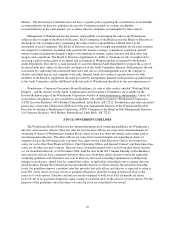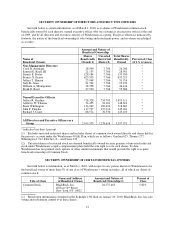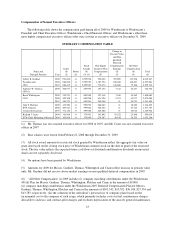Windstream 2009 Annual Report Download - page 24
Download and view the complete annual report
Please find page 24 of the 2009 Windstream annual report below. You can navigate through the pages in the report by either clicking on the pages listed below, or by using the keyword search tool below to find specific information within the annual report.
Retirement Plans. Windstream maintains a defined benefit pension plan and a qualified 401(k) defined
contribution plan for its executive officers and employees. Participation in the pension plan is frozen except for a
5 year transition period for participants who were above the age of 40 with at least two years of service at the end
of 2005 and bargaining unit employees. Messrs. Gardner and Crane continue to be eligible to accrue benefits
under the pension plan until December 31, 2010.
Windstream maintains a 401(k) plan which provides for potential matching employer contributions of up to
4% of a participant’s compensation. The Compensation Committee maintains the 401(k) plan in order to provide
employees with an opportunity to save for retirement with pre-tax dollars. The 401(k) plan also allows
Windstream to fund its contributions to this plan in a predictable, consistent manner.
Deferred Compensation Plans. Windstream maintains the 2007 Deferred Compensation Plan to provide a
non-qualified deferred compensation plan for its executive officers and other key employees. The Compensation
Committee adopted this plan as part of its effort to provide a total compensation package that was competitive
with the compensation arrangements of other companies. The plan also offers participants the ability to defer
compensation above the IRS qualified plan limits.
Change-In-Control Agreements. During 2006, the Compensation Committee approved change-in-control
agreements for Mr. Gardner and each executive officer in order to provide some protection to those individuals
from the risk and uncertainty associated with a potential change-in-control. The Compensation Committee also
adopted the change-in-control agreements as part of its efforts to provide a total compensation package that was
competitive with the compensation arrangements of other market participants. Prior to approving the
change-in-control agreements in 2006, the Compensation Committee specifically engaged Watson Wyatt to
review the payment multiples and other terms of the change-in-control agreements, to compare such provisions
against prevailing market practices, and to provide recommendations on the final terms of the agreements. When
it approved the change-in-control agreements, the Compensation Committee considered the total amount of
compensation that each other executive officer would receive in a hypothetical termination under all of the
change-in-control benefits described below.
Based on the foregoing, the Compensation Committee approved the payment of change-in-control benefits
to the executive officers on a “double-trigger” basis, which means that a change-in-control of Windstream must
occur and the officer must terminate employment with Windstream through either a resignation for “good
reason” or a termination without “cause” (as those terms are defined in the change-in-control agreement). Upon a
qualifying separation from service, the executive officers are eligible for a cash, lump sum payment based upon a
multiple of base salary and target bonus of three times for Messrs. Gardner, Whittington, and Fletcher and two
times for all other named executive officers.
In the event of a change-in-control, Windstream has also agreed to provide lump sum cash payments equal
to the value of medical and dental benefits for a period of 36 months for Messrs. Gardner, Whittington, and
Fletcher and 24 months for all other named executive officers. Windstream has also agreed to provide, at its
expense, outplacement services from a recognized outplacement provider, except that Windstream’s cost for such
services will not exceed $50,000 in the case of Messrs. Gardner, Whittington, and Fletcher and $25,000 in the
case of any other named executive officer. Also, under the terms of Windstream’s agreements for its equity
compensation awards of restricted stock or performance-based restricted stock, the unvested equity awards held
by the executive officers will vest on a “double-trigger” basis that is substantially similar to the events that
trigger the cash payments under the change-in-control agreements. For change-in-control agreements adopted
prior to 2009, Windstream is obligated to reimburse each executive officer for excise taxes imposed on such
individual pursuant to Section 4999 of the Internal Revenue Code as a result of the foregoing payments if the
payments exceed 110% of the greatest amount payable to the executive without triggering excise taxes. The
change-in-control agreements were amended in 2008 to comply with the final regulations issued under
Section 409A of the Internal Revenue Code and to clarify the scope of the non-compete provisions. In
consideration of these changes, the term of the agreements was extended one year. No changes have been made
20
























